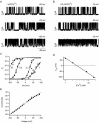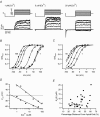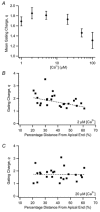Variation in large-conductance, calcium-activated potassium channels from hair cells along the chicken basilar papilla
- PMID: 12562934
- PMCID: PMC2342658
- DOI: 10.1113/jphysiol.2002.029785
Variation in large-conductance, calcium-activated potassium channels from hair cells along the chicken basilar papilla
Abstract
The mechanism for electrical tuning in non-mammalian hair cells rests within the widely diverse kinetics of functionally distinct, large-conductance potassium channels (BK), thought to result from alternative splicing of the pore-forming alpha subunit and variable co-expression with an accessory beta subunit. Inside-out patches from hair cells along the chicken basilar papilla revealed 'tonotopic' gradations in calcium sensitivity and deactivation kinetics. The resonant frequency for the hair cell from which the patch was taken was estimated from deactivation rates, and this frequency reasonably matched that predicted from the originating cell's tonotopic location. The rates of deactivation for native BK channels were much faster than rates reported for cloned chicken BK channels including both alpha and beta subunits. This result was surprising since patches were pulled from hair cells in the apical half of the papilla where beta subunits are most highly expressed. Heterogeneity in the properties of native chicken BK channels implies a high degree of molecular variation and hinders our ability to identify those molecular constituents.
Figures








Similar articles
-
Modeling hair cell tuning by expression gradients of potassium channel beta subunits.Biophys J. 2002 Jan;82(1 Pt 1):64-75. doi: 10.1016/S0006-3495(02)75374-5. Biophys J. 2002. PMID: 11751296 Free PMC article.
-
beta subunits modulate alternatively spliced, large conductance, calcium-activated potassium channels of avian hair cells.J Neurosci. 2000 Mar 1;20(5):1675-84. doi: 10.1523/JNEUROSCI.20-05-01675.2000. J Neurosci. 2000. PMID: 10684869 Free PMC article.
-
Expression of Ca2+-activated BK channel mRNA and its splice variants in the rat cochlea.J Comp Neurol. 2003 Jan 6;455(2):198-209. doi: 10.1002/cne.10471. J Comp Neurol. 2003. PMID: 12454985
-
Mechanisms of hair cell tuning.Annu Rev Physiol. 1999;61:809-34. doi: 10.1146/annurev.physiol.61.1.809. Annu Rev Physiol. 1999. PMID: 10099711 Review.
-
BK Channels in the Vertebrate Inner Ear.Int Rev Neurobiol. 2016;128:369-99. doi: 10.1016/bs.irn.2016.03.016. Epub 2016 Apr 20. Int Rev Neurobiol. 2016. PMID: 27238269 Review.
Cited by
-
Cholesterol influences voltage-gated calcium channels and BK-type potassium channels in auditory hair cells.PLoS One. 2011;6(10):e26289. doi: 10.1371/journal.pone.0026289. Epub 2011 Oct 14. PLoS One. 2011. PMID: 22046269 Free PMC article.
-
β4-subunit increases Slo responsiveness to physiological Ca2+ concentrations and together with β1 reduces surface expression of Slo in hair cells.Am J Physiol Cell Physiol. 2011 Mar;300(3):C435-46. doi: 10.1152/ajpcell.00449.2010. Epub 2010 Dec 22. Am J Physiol Cell Physiol. 2011. PMID: 21178105 Free PMC article.
-
Expression of BK-type calcium-activated potassium channel splice variants during chick cochlear development.J Comp Neurol. 2010 Jul 1;518(13):2554-69. doi: 10.1002/cne.22352. J Comp Neurol. 2010. PMID: 20503427 Free PMC article.
-
A residue at the cytoplasmic entrance of BK-type channels regulating single-channel opening by its hydrophobicity.Biophys J. 2008 May 1;94(9):3714-25. doi: 10.1529/biophysj.107.120022. Biophys J. 2008. PMID: 18400952 Free PMC article.
-
The large-conductance Ca(2+)-activated K(+) channel interacts with the apolipoprotein ApoA1.Biochem Biophys Res Commun. 2009 Oct 2;387(4):671-5. doi: 10.1016/j.bbrc.2009.07.074. Epub 2009 Jul 18. Biochem Biophys Res Commun. 2009. PMID: 19619511 Free PMC article.
References
-
- Atkinson NS, Robertson GA, Ganetzky B. A component of calcium-activated potassium channels encoded by the Drosophila slo locus. Science. 1991;253:551–555. - PubMed
-
- Bers DM, Patton CW, Nuccitelli R. A practical guide to the preparation of Ca2+ buffers. Methods Cell Biol. 1994;40:3–29. - PubMed
-
- Butler A, Tsunoda S, McCobb DP, Wei A, Salkoff L. mSlo, a complex mouse gene encoding ‘maxi’ calcium-activated potassium channels. Science. 1993;261:221–224. - PubMed
Publication types
MeSH terms
Substances
Grants and funding
LinkOut - more resources
Full Text Sources

